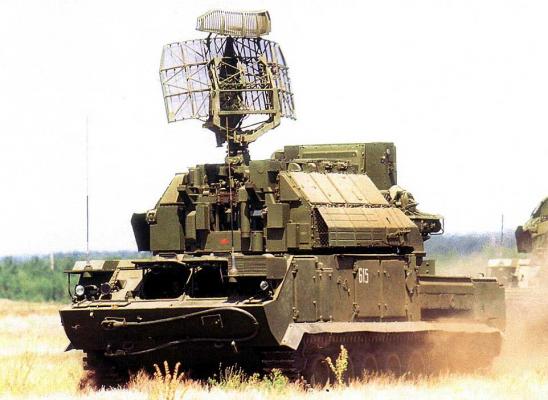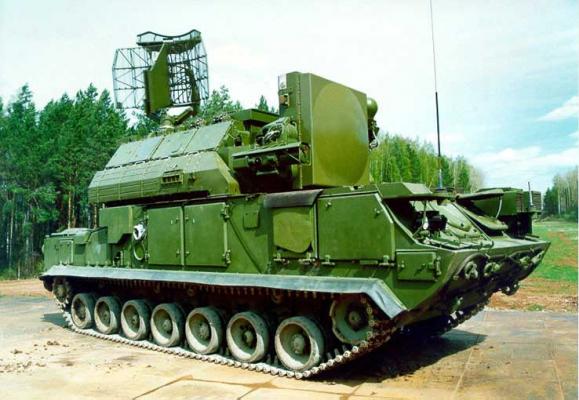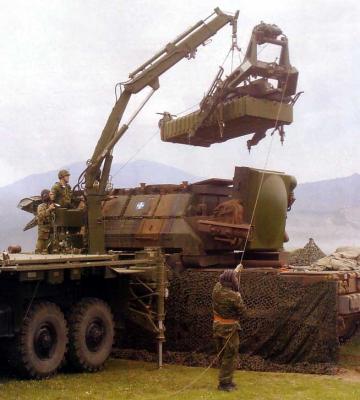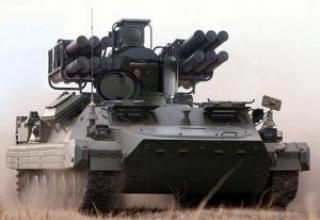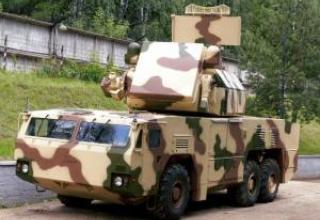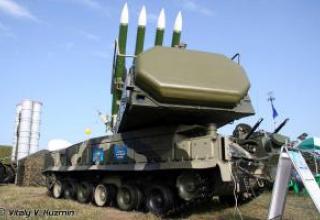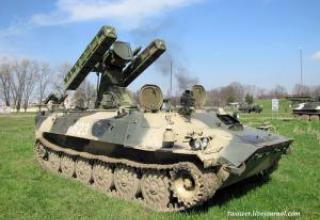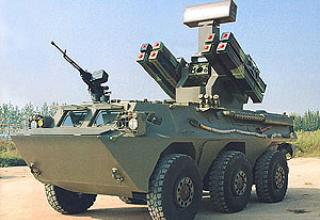The 9K331 "Tor-M1" autonomous self-propelled air defense missile system (SAM) is designed for air defense of motorized rifle and tank divisions in all types of combat operations and in the areas of concentration, protection of the most responsible objects (command posts of communication centers, Radio equipment, bridges, airfields) from the strikes of high-precision weapons, guided and anti-radar missiles, guided air bombs, aircraft, helicopters, cruise missiles and remotely-piloted aircraft (UAV).
The complex is a compact functionally complete and technically perfect tactical unit - a combat vehicle capable of carrying out a given combat mission independently or as part of an air defence system. The 9K331 SAM system is the result of consistent modernization of the Tor SAM system. As a result of the modernization, a second target channel was introduced into the SAM system, BC made of high defensive characteristics was used in the SAM, modular interfacing of the SAM with a combat vehicle was implemented, the zone and probability of engagement of low-flying targets were increased, and the combat vehicle was interfaced with a unified battery command post "Rangzhir" to provide control of combat vehicles as part of a battery.
The Tor-M1 (9K331) SAM system took part in the modification of the existing and development of new facilities:
- Electromechanical Research Institute MRP (leading enterprise NPO "Antey") - head of Tor-M1 SAM system as a whole (chief designer V.P.Efremov) and 9A331 combat vehicle (modernization 9A330) - Deputy Chief Designer of SAM system and Chief Designer of 9A331 combat vehicle - I.M.Drize;
- Production Association "Izhevsk Electromechanical Plant" MRP - on the design improvement of the combat vehicle;
- Kirov Machine Building Production Association named after XX MAP Party Congress - to develop a four missile module 9M334, used in the 9A331 combat vehicle (chief designer of the module O.N.Zhary);
- Research Institute of MPS Automation Means (leading enterprise of SPA "Agat") - on the development of a unified battery command post "Rangzhir" within the framework of a separate RCD. (9С737) - Chief Designer A.V.Shershnev, as well as ICB "Torch" MAP and other organizations.
State tests of the Tor-M1 SAM system were carried out from March to December 1989 at the Emba range (range commander V.R. Unuchko). The SAM system was adopted for service in 1991.
The serial production of combat and technical means of the Tor-M1 SAM system was organized at the enterprises, which produced the Tor SAM system. New vehicles - a four-seat transport and launch container for the 9A331 SAM and a unified battery command post 9C737 - were manufactured at the Kirov Machine Building Plant named after XX of the Party Congress and Penza Radio Plant, respectively.
Having no analogues in the world, the Tor-M1 SAM system (see comparative characteristics), capable of engaging air elements of high-precision weapons, has repeatedly demonstrated its high combat capabilities at training and combat firing, at military exercises at exhibitions of modern weapons in a number of countries. These complexes have good competition on the world market and are in service with air defense units of China, Greece and Iran.
For protection of sedentary military, and also civil and industrial objects variants of a complex with placing of the basic elements on wheel bases are developed - in a self-propelled variant "Tor-M1TA", with placing of a hardware cabin (AK) on the automobile "Ural-5323", and an antenno-launching post (APP) - on trailer CHMZAP8335, in towed "Tor-M1TB" (on two trailers AK - SMZ-782B, APP - CHMZAP8335). At the expense of refusal of cross-country ability on off-road and increase in time of deployment/cooling up to 8 ... 15 minutes the decrease in cost of a complex is reached. The stationary variant of "Top-M1TC" complex was also developed.
The upgraded version of the complex was tested and got the designation "Tor-M1B". The "Tor-M1B" differs from its predecessor by increased combat capabilities:
- the affected area of the system has been extended in terms of height and heading parameter. The need for such expansion is dictated by the experience of aviation operations in Yugoslavia and the Middle East;
- the interference immunity of the complex has been increased in the conditions of the enemy's use of self-defence hindrances. For this purpose, special modes of combat vehicles operation have been developed, which are automatically activated when modern and prospective interferences are set;
- a special combat operation mode "link" was introduced for co-ordinated and effective operation of two combat vehicles without a battery command post when protecting point objects.
At the International aerospace interior "MAKS - 2007" Open Society ' the Izhevsk electromechanical factory ' the Dome ' together with Open Society ' the Concern of air defence ' the Diamond - Antey ' has presented the newest working out - the fighting machine 9А331МК of anti-aircraft rocket system " Tor-M2E ". The new system is notable for its increased effectiveness in repulsing massive attacks of modern airborne assault vehicles under fire and electronic countermeasures.
Composition:
The 9K331 complex includes:
- The 9A331 combat vehicle and the 9M334 anti-aircraft missile module (with 9M331 missiles in the 9Y281 transport and launch container);
- 9T244 transport and charging machine;
- transport vehicle 9T245;
- 9B887M and 9B888-1M maintenance vehicles
- set of rigging equipment 9F116;
- group ZIP machine 9F399-1M1;
- autonomous electronic simulator for 9F678 combat meddling operators.
On the basis of the 9A331 fighting vehicle (see layout) are placed:
- Two 9M334 anti-aircraft missile modules (eight 9M331 missiles in TPK 9Y281);
- three-axis target detection station (TDS) with systems of identification of their nationality and stabilization of the antenna base;
- pointing station (SN) with phased antenna array;
- a duplicate television and optical vizier providing auto-steering of the target at angular coordinates;
- a high-speed digital computer system;
- Launching machine equipment (equipment for displaying information about the air situation and the combat cycle, as well as for indicating the functioning of combat vehicle systems and facilities, commander and operator work stations and auxiliary equipment);
- a system of telecode operational-command radio communications;
- navigation, topographic and orientation equipment;
- system of functional control of the combat vehicle:
- Autonomous power supply and life support system (primary power supply source with electric generator drive from gas turbine engine or self-propelled chassis running engine).
The following changes were made to the 9A331 combat vehicle (compared to 9A330):
- a new dual-processor computer system of increased performance was used, which implemented two-channel work on targets, protection against false traces of targets, enhanced functional control;
- in the target detection station introduced a three-channel digital signal processing system, which provided improved suppression of passive interference without additional interference analysis, automatically switchable selective filter in the receiver's input devices, which provided through the frequency selection of each unit more effective electromagnetic compatibility and interference immunity of the station, in the receiver's input devices was replaced by an amplifier to increase sensitivity, introduced automatic adjustment of mo
- a new type of sounding signal was introduced in the guidance station, which provided detection and auto tracking of a hovering helicopter, an automatic target tracking machine was introduced in the television and optical viewer at the corner of the location (to improve the accuracy of its tracking), an improved commander indicator was introduced, and interface equipment with a unified battery command post "Rangir" was introduced. (radio stations and data transmission equipment).
The detection radar is a coherent-pulse circular view radar. It operates in a centimeter range of waves with frequency-controlled beam angles. The average power of the transmitter is 1.5 kW, the resolution is not worse than 1.5-2.0° azimuth, 4° angle and 200m range. Maximum target coordinate errors are not more than half of the resolution values specified. The use of digital signal processing allows reliable detection of both high-speed and low-movement (up to 10 m/s) targets without "blind speeds" in difficult conditions of passive (natural and artificial) interference, taking into account the influence of the underlying surface. Signal processing is carried out by special calculators and a central computer, the computational and algorithmic capabilities of which allow to solve the tasks of air situation analysis, making basic decisions and other intellectual tasks of combat operations control. The detection radar is linked to the target identification system and automatically blocks (with a high probability) the possibility of "own" aircraft being hit. To ensure the possibility of station operation during the movement of the FM, the antenna position is stabilized.
The station is capable of detecting F-15 type aircraft flying at altitudes from 30 to 6000m with a probability of not less than 0.8 at a range of 25-27km. Unmanned aircraft are detected with a probability of not less than 0.7 at a range of 9-15km, helicopters hovering in the air - with a probability of 0.6-0.8 at a range of 13-20km, helicopters on the ground with rotating propellers - with a probability of 0.4-0.7 at a range of 13-20km. Targets covered by active and passive interference may also be detected. The detection radar provides a multipartial (8 pairs - beams) three-axis view of the space with high speed (see scanning range). The scanning period is 1s, the beam width in the vertical plane is 4°. Angular space scan in the vertical plane is mechanically divided into two ranges from 0-32° and 32-64°. This means that two "Top-M1" SAM batteries can simultaneously view the area in the 0-64° angle scan. The signal energy can be increased by using a long pulse with intra-pulse modulation and the mode of concentration of all the radiation energy in one particle - three in one.
Guidance radar (SVR) - coherent-pulse (pulse-doppler type) radar. It operates in the centimeter wavelength range, has a low-element framed antenna array (FAR), forming a beam width of 1 ° on the azimuth and the angle of the place, providing electronic scanning of the beam in the appropriate planes. This construction of the system allows for almost instant (400-600ms) transition to auto tracking, as well as simultaneous tracking and firing of two targets in the sector PHAR. The station searches for a target based on target designation data from the target detection station and captures one target for auto-leaders. With a probability of 0.5, the guidance station is capable of switching to a fighter aircraft auto-guard, flying at a range of 23 km. With decreasing range this probability increases significantly, so, at a range of 20 km it is already 0.8. The tracking radar signal processing system - digital monopulse with pulse compression and corresponding signal processing algorithm, provides not only high accuracy and interference protection, but also recognition of target class, which allows to optimize the operating modes of the guidance system and its combat equipment.
For the first time in the practice of creating anti-aircraft complexes, a four-seat transport and launch container (TLC) 9Y281 was used for the air defense systems of Tor-M1, which together with the 9M331 missile module 9M334. Each 9M334 module is equipped with two special beams, with which the modules can be assembled into multi-tier packages. Such packages store and transport missiles at all stages of operation. Transport vehicle 9T245 transports two packages of four modules, transport and charging machine 9T244 - two packages of two modules and has a crane equipment to load the module in the combat vehicle. The BM is charged by the transport and charging vehicle. First, the module is moved from a horizontal to a vertical position, then it is lowered into the PM shaft. The time of charging the combat vehicle with two modules is 25 minutes. The 9M334 module is operated during the set service life without any routine works and inspections of onboard equipment of missiles. Main parameters of the module: mass of the module (TPK plus four missiles) with two beams - 1053kg, mass of TPK with two beams - 333kg, mass of one beam - 40kg, dimensions of the module with two beams - 539x1507x3005mm.
SAM 9M331 is fully unified with missile 9M330 (except for the material of striking elements of BC) and can be used in "Tor", "Top-M1", "Tor-M2" and ship's SAM "Dagger".
The combat operation of 9K331 SAM system is based on the scheme usual for anti-aircraft missile systems with radio command guidance system (see description of combat operations). The station of detection in motion or on the spot provides a circular view of the space, detects and identifies targets. The combat vehicle's computer facilities analyse the air target, select the most dangerous targets to be fired on and produce target designation data for the guidance station (command transfer station, PIC). The guidance station (missile sighting station plus command transfer station) produces target designation data based on the target designation data:
- searching for and capturing one target for a car escort;
- precise tracking of the target at three coordinates;
- launching one or two missiles in sequence (4s) on the escorted target;
- capture of the missile after launch by a separate coordinator and inject it into the beam of the phased array antenna;
- precise tracking of the missile;
- control of the missiles by commands generated by the difference in coordinate between the missiles and the target according to the chosen guidance method corresponding to the most optimal conditions for the missile to meet the target, depending on its type, altitude and nature of flight;
- issuing a delay command to the missile's fuze, depending on the speed at which the missile approaches the target.
Operation of the complex is permitted at altitudes not exceeding 3000 m above sea level, at any time of year and day, in various meteorological conditions in the range of ambient air temperatures from -50°C to +50°C, in conditions of solar radiation and relative humidity not exceeding 98% at temperature (30 ± 5)°С and wind speed not exceeding 20 m/sec. The mode of operation of the missile's equipment at war machine switching on is cyclic: 10 minutes of operation - 10 minutes break. After three engagements there should be a break of at least one hour. At any time of the break it is allowed to switch on the rocket equipment once for one minute to conduct the launch.
Characteristics:
| Number of simultaneously detectable targets | 48 |
| Number of simultaneous targets | 2 (4 for Tor-M2E) |
| The detection area: - in range, km - azimuth, deg - corner of the place, deg - by height, km |
27 360 0-32 or 32-64 not less than 23 |
| Defeat zone, km: - at a distance - in height - as defined in |
1..12 0.01...6 (0.01...10 for Tor-M2E) 6 (8 for Tor-M2E) |
| Probability of hitting one missile: - aircraft (type F-15) - helicopter - cruise missiles - precision weapon |
0.45-0.8 0.62-0.75 0.93-0.97 0.75-0.9 |
| Maximum target speed (inhaling/attacking) m/s | 700 |
| Maximum transverse overload of the targeted target | 10 |
| The reaction time of the complex (from the target detection to the missile launch), s: - from the point of view of - at a short stop |
7.4 9.7 |
| The weight of the fighting vehicle. | 37 |
| Power reserve on fuel (with two hours of equipment operation), km | 500 |
| Battle calculation | 3 |
| ZUR flight speed, m/s | 700..800 |
| Mass of the rocket, kg | 165 |
| Weight of combat unit, kg | 14,5 |
Testing:
Tests of the SAM system "Tor" was held from December 1983 to December 1984 at the Emba test site under the leadership of a commission headed by R.S. Asadulin. By a decree of the CPSU Central Committee and the USSR CM of March 19, 1986 SAM system was adopted.
Series production of the 9A330 combat vehicle was organized at the Izhevsk Electromechanical Plant MRP, ZUR 9M330 - at the Kirov Machine-Building Plant named after XX MAP, tracked chassis - at the Minsk Tractor Plant IUFM.
The complex provided defeat of the target flying at a speed of 300 m/s at altitudes from 0.01 to 6 km in the range of 1.5 to 12 km with the parameter up to 6 km. At a target speed of 700 m/s, the maximum range was reduced to 5 km, the range of engagement height was narrowed to 0.05 to 4 km and the parameter did not exceed 4 km.
The effectiveness of a single SAM was 0.30-0.77, 0.50-0.88 for helicopters and 0.85-0.955 for UAVs.
The reaction time of the complex was 8 ... 12 seconds, the transfer to combat and marching positions - 3 minutes, the charging of the combat vehicle with TZM - no more than 18 minutes.
Organizationally, "Tor" SAMs were reduced to anti-aircraft missile regiments of divisions. The regiments consisted of the regiment command post, four anti-aircraft missile batteries (4 combat vehicles 9A330 and a battery command post in each), support and service units.
As a battery command post, the PU-12M control points were temporarily used, and as a regiment control point, the PU-12M or the MP25 data acquisition and processing machine and the MP22 combat control machine, developed as part of the Automated Troops Control System (ATCS) of the front and also included in the division's Air Defense Chief's automated control point. The P-19 or 9C18 ("Dome") detection radars of the regiment's radar company were paired with the regiment's control gear.
The main type of combat work of the SAM system "Tor" was the autonomous operation of batteries, but not ruled out the centralized and mixed management of these batteries division air defense chief and commander of the anti-aircraft missile regiment.
Sources:
- Ельцин С.Н. и др "Устройство и функционирование зенитной ракеты 9М331 "Тор-М1": учебное пособие, БГТУ "Военмех"
- Зенитные ракетные комплексы ПВО СВ. Техника и вооружения №5-6.99
- Вестник ПВО
- Аналогов "Тору" не существует
- «Ранжир» (9С737), «Ранжир-М» (9С737М), «Ранжир-МК» (9С737МК), семейство автоматизированных систем управления средствами ПВО
